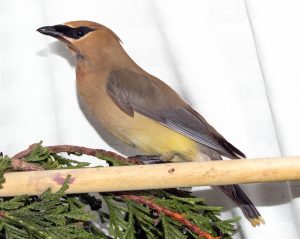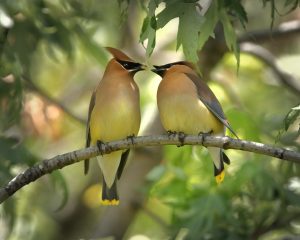Support Us
Since 1979 more than 140,000 animals have been treated by Wildlife Rescue.
Thanks to the support of individuals like you, Wildlife Rescue can provide a lifeline for animals in distress.
With a black stripe on their pale brown heads, light grey wings tipped with red, and a short tail tipped with yellow, Cedar Waxwings can be spotted near streams and grasslands in British Columbia all year. However, they can be seen more frequently during the breeding season which typically lasts from June through August. Their wide bills help them gather foods such as fruits and berries.

Waxwing’s diet mainly revolves around fruits and berries (such as strawberries, mulberries, and raspberries). Large quantities of over-ripe fruit that contain alcohol sugar from the fruit converts into alcohol through fermentation. This can be fatal for a Cedar Waxwings diet by causing disorientation leading to window strikes.
These brilliant birds also eat protein-rich insects – which includes dragonflies and mayflies as well as leaf beetles and spruce budworm. Other components of their diet include mistletoe, juniper, crabapple and cedar berries in the winter – which is how they got their name.
Urbanization poses a Threat for Travelling Birds
Recently, two Cedar Waxwings were admitted to Wildlife Rescue after both struck a large window in a residential home in Coquitlam. The injuries the duo suffer include head trauma, pectoral muscle bruising, and an air sac puncture that causes swelling around the body. Luckily, the injuries are treatable with supportive care and extensive therapy and medication.
Unfortunately, window strikes are common for birds – the deceptive nature of our windows makes them a hazard that causes almost a billion bird deaths each year. Of course, British Columbia’s urbanization is also doing much harm to our flying friends as well, since they are losing both their habitat and their food.
Cedar Waxwings are attracted to fruit-bearing plants in areas such as parks and gardens are so it is natural that they would also build their nests close to these locations in trees such as maple, pine, and hawthorn. The females craft the nests in around five or six days by weaving together grass, string, and twigs and then lining it using pine needles and grass. She may even decorate the outside by adding oak and hickory catkins.

Support Your Local Cedar Waxwing Birds!
While the statistics are disheartening, there is still much we can do to help these birds. Read tips on how to help protect wildlife this summer here. If you are looking to attract this beautiful bird to your backyard these tips will help you….
If you see a bird that has exposed bone or blood, bugs or insects covering it, no feathers, or a bird that is sleeping, human intervention is required. Please contact our Support Centre for assistance.
Making simple changes such as modifying our windows, leaving trees alone, and rescuing birds in need are great ways to support this beautiful species. Donating to Wildlife Rescue is another easy way to help – we provide rehabilitation to over 5,000 animals a year with unique care for every one of them. Learn more about donating here.